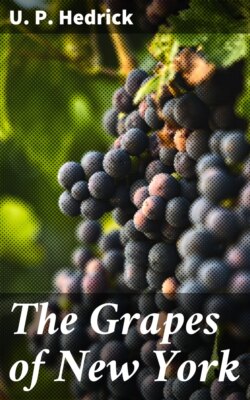Читать книгу The Grapes of New York - U. P. Hedrick - Страница 31
На сайте Литреса книга снята с продажи.
9. VITIS RUBRA Michx.
ОглавлениеTable of Contents
1. Vahl,[141] Symb. Bot., 3:42. 1794. V. palmata. 2. Willdenow, 1:1180. 1797. V. palmata. 3. Muhlenberg, 1813:27. V. palmata. 4. Pursh, 1:170. 1814. V. palmata. 5. Nuttall, 1:143. 1818. V. palmata. 6. Rafinesque, 1830:18. V. palmata; Palmate grape. 7. Ib., 1830:18. V. virginiana; Virginia grape. 8. Floy-Lindley, 1833:152. V. palmata; Palmated leaved. 9. (?) Le Conte, Proc. Phil. Acad. Nat. Sci., 6:274. 1853. V. palmata; V. Virginiana; Bland’s grape. 10. (?) Ib., U. S. Pat. Off. Rpt., 1857:231. V. palmata; Palmate-leaved vine; Bland’s grape; V. Virginiana. 11. Engelmann, Bush. Cat., 1883:10, 11, 12, 14, 17. V. palmata; V. rubra; Red grape of the Mississippi Valley. 12. Munson, Am. Hort. Soc. Rpt., 1885:133. V. palmata; V. rubra. 13. Ib., Am. Pom. Soc. Rpt., 1885:97. V. palmata; Palmate-leaved grape; V. rubra. 14. Ib., Soc. Prom. Ag. Sci. Rpt., 1887:59. V. palmata; Eggert’s grape. 15. Planchon, De Candolle’s Mon. Phan., 5:352. 1887. V. riparia, var. PALMATA; V. Virginiensis; V. Virginiana. 16. Ib., Ib., 5:354. 1887. V. palmata. 17. Sargent, Gar. and For., 2:340. 1889. fig. V. palmata; V. rubra. 18. Munson, Ib., 3:474, 475. 1890. V. palmata. 19. Munson, U. S. D. A. Pom. Bul., 3:13. 1890. V. palmata. 20. Ib., Am. Gard., 12:586. 1891. 21. Bailey, Gray’s Syn. Fl., 1:423. 1897. V. palmata; V. monosperma; V. rubra; V. riparia, var. palmata; Red grape; Cat grape. 22. Britton and Brown, 2:410. 1897. fig. V. palmata; Missouri grape. 23. Bailey, Ev. Nat. Fr., 1898:105. V. palmata; Red grape; Cat grape. 24. Munson, Tex. Sta. Bul., 56:230, 239. 1900. V. palmata; Cat Bird grape. 25. Bailey, Cyc. Am. Hort., 4:1952. 1902. V. monosperma; Red grape. 26. Viala and Ravaz, Am. Vines, 1903:42, 113.
Vine slender, of only moderate vigor, climbing very high. Shoots smooth, angled, long-jointed, bright red; diaphragms thick to medium; tendrils intermittent, long, usually bifid. Leaves with short, broad stipules; leaf-blade broadly cordate in outline, rarely entire, frequently very deeply three or even five-lobed, lobes long, acuminate; margin with broad, shallow, serrate teeth; petiolar sinus rather broad and shallow; upper surface dull dark green, smooth; lower surface frequently somewhat pubescent on ribs and veins; petioles red. Clusters medium to large, loose, seldom compound; long peduncle. Berries small, black, without bloom, not juicy. Seeds one or two, large, plump, rounded, with very short beak, slightly notched; chalaza narrow, rather indistinct; raphe indistinct.
Vitis rubra and Vahl’s Vitis palmata are badly confused. The species was first described by Vahl in 1794, from plants cultivated in the Jardin des Plantes in Paris and supposed to have been sent by some missionary from the Mississippi Valley. It was so named on account of its tendency to five-lobed leaves. Vahl erroneously gives its habitat as Virginia. About the same time, Michaux discovered, on the banks of the Mississippi and adjacent streams, a grape which he called Vitis rubra, on account of its characteristic bright red shoots. The descriptions of these two varieties were copied from time to time by other botanists, but with no additional details of any importance until Engelmann, in 1883, made the claim that they were identical. There is no question as to the identity of Michaux’s Rubra, but some botanists question whether Palmata is a synonym. We have taken Michaux’s name as the one to which there is no question, although Engelmann was so careful a worker that it is highly probable that he is correct in considering the two species synonymous. Munson considers the species as probably a multiple “hybrid of Cordifolia with Riparia, with possibly a trace of Cissus blood, indicated in the fruit, seed and leaf.” There seems to be but little evidence to support this supposition. Planchon says it is principally on the evidence of Millardet that he admits this as a separate species and that perhaps it would be better to consider it a variety of Riparia closely allied to Vahl’s Palmata.
Vitis rubra is an inhabitant of sandy, rich, moist, alluvial river bottoms in Missouri and Illinois, to Louisiana and Texas, in which region it is quite restricted and apparently not plentiful.
But little is known of the horticultural characters of Vitis rubra. In spite of its having been classed with Riparia, it appears to resemble more closely Vitis cordifolia, having the thick diaphragms and late blooming characters of the latter species, but the seeds resemble those of Riparia. Rubra grows readily from cuttings and the roots are said to be very resistant to phylloxera. It is not sufficiently vigorous, however, to be recommended as a stock. It is sometimes cultivated as an ornamental but is of no horticultural importance beyond this.
